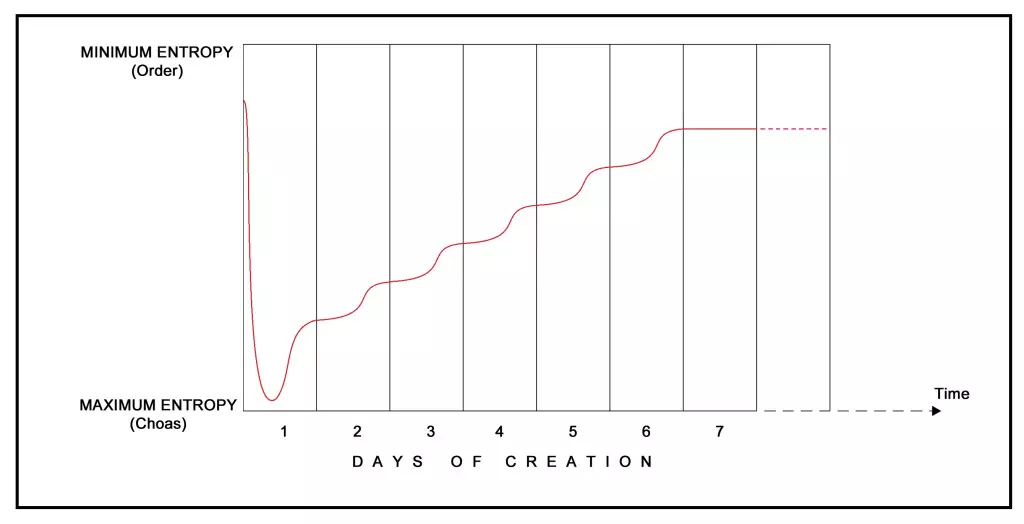[Originally published as From Genesis to Jesus: Part 1]
Contrary to the mainstream notions of random naturalistic events bringing about the advent of reality and all that exists, the Bible provides a much different account.
As Genesis records, the Creator established this entire reality over the course of six days in several distinct acts of creation,
- beginning with the establishment of the universe and the fundamental forces that govern it,
- continuing with the creation of earth and its environmental features,
- the advent of vegetative life,
- the formation of the heavenly bodies,
- and the birth of animal life across the world, in the seas and the air and on land.
His final creative act was the advent of man and woman.
For those who put their faith in the Genesis account, there are several common ways of interpreting it. Personally, I believe there is only a single, proper way to understand it.
Looking at the original language in which Genesis had arrived to us, Hebrew, we find that each day of creation is noted by the phrase “yom”. While it is true that the term can be utilized in a number of ways to describe a “sufficient” passage of time (i.e. just as in the English language we would say something happened in George Washington’s “day”), what we find, quite obviously I might add, is that the phrasing in Genesis makes it clear that each day, yom, is referring to a single period of 24-hours or so. How is this clear? Consider the following phrases:
Genesis 1:5b And the evening and the morning were the first day.
Genesis 1:8b And the evening and the morning were the second day.
Genesis 1:13 And the evening and the morning were the third day.
Genesis 1:19 And the evening and the morning were the fourth day.
Genesis 1:23 And the evening and the morning were the fifth day.
Genesis 1:31b And the evening and the morning were the sixth day.
Can you see a pattern there? It would appear that the use of yom here specifically refers to a single night/day cycle. In fact, what we find is that the phrase is used throughout the Old Testament some 2301 times, with the specific references of “evening” and “morning”, occurring some 38 times, always indicates a single 24-hour day, and likewise so with the 52 references to yom when paired with the phrase for night.
There simply is no logical and linguistically-accurate way to ascribe any period of time to these occurrences beyond that of a singular day, and in fact that was for generations the standard interpretation of the material. It has only been in the last two-hundred years, with the advent of the naturalistic interpretations of science, that these understandings have shifted, being indelibly corrupted through acquiescence.
However there is something worth noting when we consider how this applies to verse 5 of Genesis 1. Consider how it notes that “the evening and the morning were the first day.”
Now, it is from this arrangement of evening leading into morning that Jews derived their understanding of a day, but could it be that originally the words behind “evening” and “morning” had an additional different meaning? The Scriptures, we must understand, are absolutely full of statements and passages that hold a multiplicity of significant meanings, each standing valid on its own without ever negating the others! As Dr. Chuck Missler has noted¹, the origins of their Hebrew roots may indicate a deeper truth.
Evening, or “Erev” as it is recognized in Hebrew, seems to originally have indicated a certain sense of obscurity, darkness, even confusion. As Missler contends, this confusion relies well to the technical understanding of entropy, which implies randomness or disorder within a system. Likewise, he contends that morning, “Boker” in Hebrew, may originally have been a reference to a relief in obscurity, a growing discernibility, a heightening of perception. In a sense, it would be a decrease in overall entropy; an increase in order in the midst of chaos.
We read in Genesis of how each day possessed an “evening and a morning.” There is however an exception: the seventh day did is not recorded like the others in regard to possessing an “evening” and a “morning.” Certainly these events occurred, but could Missler be accurate that its absence on the seventh day is a reference to God’s creative processes having come into a state of repose?
If we imagine the creation as starting in a certain condition of darkness and disorder, with each day bringing about a clearer resolution to the universe through God’s intervention, we could contend that, as entropy decreased, order increases! In other words, as each day comes and goes, the universe becomes ever more complete and discernable as we would recognize it.

As the figure above demonstrates, the universe may have been created with a high degree of order and structure which rapidly would have descended into a state of confusion (this will be addressed shortly), and from the subsequent state of high entropy it would have experienced a fundamental decrease in chaos and confusion as the six days of creation carried on, stabilizing by the end of that sixth day. By the Seventh Day, we would find the universe at an all-time low for entropy. This of course would ultimately have shifted, leading to the state we now find in our world, where the natural laws of nature seem to invariably lead order to chaos.
Whether one accepts Missler’s contentions about decreasing entropy throughout Creation Week, there can be no debate over the fact that that it took place over the course of six true days. For Bible believers, we need look no further than Exodus 20:11, in which Scripture itself clearly and unmistakably proclaims the true interpretation of the language:
For in six days the Lord made heaven and earth, the sea, and all that in them is, and rested the seventh day: wherefore the Lord blessed the Sabbath day, and hallowed it.
In fact, upon reading the start of that chapter, we find it was God Himself who said this!
Still, there are many believers, entire denominations in fact (including prominent Christian voices), who insist on maintaining other beliefs concerning the age of the creation, and in some cases, even specific details which are conspicuously absent from Scripture. These include the Gap Theory and the Day-Age Model.
– This was an excerpt from “Remnants of Eden: Evolution, Deep-Time, & the Antediluvian World.” God bless! –
Reference:
- Missler, Chuck, “Quantum Physics: The Boundaries of Reality,” Koinonia House, July 1998 Personal Update News Journal, http://www.khouse.org/articles/1998/62/, retrieved January 27th, 2017







